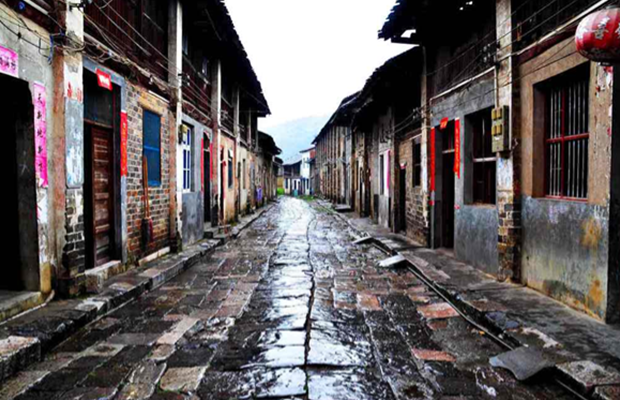于青米磚茶.jpg)

The answer would be centuries as most people believe. This saying may be right, but may be not. The reason why we think it right is because the cuboid-shape Zhuan Tea (i.e. the shape of the tea like brick) didn’t appear until centuries ago in Chibi; and we think it wrong because shape and processing of Zhuan Tea have undergone a long course of evolution and the historical inheritance is definitely beyond centuries.
Tang and Song Dynasties (Crumby-cake Tea) —— Ming Dynasty (Maohe tea) —— Qing Dynasty (Zhuan Tea) —— Nowadays (Qing Zhuan Tea)

The first stage of the Tea Road’s development was from Tang and Song Dynasties to late Ming Dynasty. It was then called the Ancient Tea Horse (Trade) Road that featured distribution and sales of bulk tea and Crumby-cake tea. In Tang Dynasty, tea gardens had been formed here and there in Yang Lou Dong. At this time, the city was famous for tea production. The initial shape of Qing Zhuan Tea, Crumby-cake tea or E’zhou yellow cake tea, already showed up and was delivered to Middle Asia along the Silk Road. When it came to Ming and Qing Dynasties, the Silk Road was completely used for Zhuan tea trade. Trade caravans from different countries came to deliver the Zhuan tea produced by Yang Lou Dong to Middle Asian and European countries.

The Kangxi Period of Qing Dynasty (namely from 1689 when Sino-Russian Treaty of Nerchinsk was signed to 1853) was the second stage of Tea Road development. The road then was called Sino-Russian Tea Road and mainly used for distribution and sales of Crumby-cake Tea, Maohe Tea, and Zhuan Tea. Signing of the Treaty of Kyakhta between China and Russia in 1727 brought further prosperity to this tea road. By that time, merchants from Shanxi province built a “trade city” along the Chinese border in Kyakhta so that the distribution of Yang Lou Dong Zhuan tea to Russia was made even more convenient.
The period spanning from 1853 (when Fujian Tea Road got cut off amid eruption of Taiping Rebellion) to the late Qing Dynasty and early Republic of China is the third stage of Tea Road development. The road was called then Eurasian Tea Road and mainly used for distribution and sales of Qing Zhuan Tea and Mi Zhuan Tea.




Green brick tea belongs to the black tea category. It has a rectangular shape with a flat brick surface, distinct edges, consistent thickness, and clear patterns. The color is green brown, the aroma is pure, the soup color is red yellow, the taste is rich, and it is rich in various substances beneficial to human health. With the aging of years, the color of the black brick tea will gradually become orange red. The tas...


The strongest aroma of green brick tea is in the baking workshop. There, semi-finished products need to be dried in high-temperature factories, and as the moisture decreases, the aroma of tea also becomes stronger. In the drying workshop. Opening the door, a faint aroma wafted in, and indeed, it was the roasted green brick tea that emitted the strongest fragrance.
The fragrance of tea is not only smelled, but also tasted. ...


Yanglou Cave has Guanyin Spring, Shiren Spring, and Liangyin Spring, all of which flow through the town like rivers. At that time, many tea houses represented by "Jushengchuan" and "Sanyuchuan" were located here. In order to highlight the importance of water and imply the prosperity of business, the word "chuan" was pressed on top of brick tea and sold to herdsmen in the border areas. When herdsmen purchase brick tea on the market, they only r...


Rice brick tea is made from rolled flakes of red tea such as Yihong, Qihong, Dianhong, etc., through processes such as replication, blending, pressing, and baking. Because the raw materials used are cut into pieces the size of rice grains during kneading and cutting, they are called "rice bricks" after being pressed and formed.
Rice bricks and tea bricks have a smooth surface, distinct edges, consistent thickness, and clear patterns. Phoe...


Phoenix: Phoenix Rice Brick Tea is a customized tea from Hubei Province commissioned by the Ministry of Foreign Affairs in 1981 to commemorate the 275th anniversary of the establishment of TWININGS, a well-known British tea company. Fenghuang Rice Brick Tea is made from high-quality black tea flakes as raw materials, using traditional techniques to imprint clear textures and exquisite patterns; Paired with finely carved wooden frames, it is a ...


Locomotive: In 1905, the Trans Siberian Railway was fully opened, and the trade route between China and Russia completely shifted from the Jin Mongolian region to the northeast. Russian merchants switched to railway transportation via Vladivostok, which was not only low-cost but also extremely convenient. The entire transportation time was only about one-fifth of the original land transportation time for horses and camels. This modification to...



The Qing Zhuan Tea (a kind of dark tea) functions to reduce lipid and weight, soften blood vessels, and prevent cardiovascular diseases. It has been proven in past hundreds of years that this tea is drink of life for herdsmen living at borders. For them, “life would be dull if cut off from the supply of black tea for one day and painful if for three days”. This is exactly the evidence of the unique medical efficacy of the dark green tea.

In the Qing Zhuan Tea, there’re a great deal of vitamins, proteins, mineral matters, amino acids, and sugars. Regular use could benefit the health, especially of those nomadic people residing in such bleak areas as deserts, gobies and plateaus with beef, mutton, and cheese as their principal food. In the northeast China that lacks vegetables and fruits, there is a popular saying which goes like: “Better three days without food than one day without tea.”

回到頂部